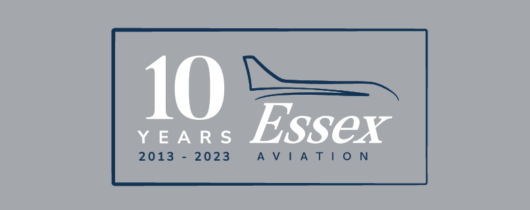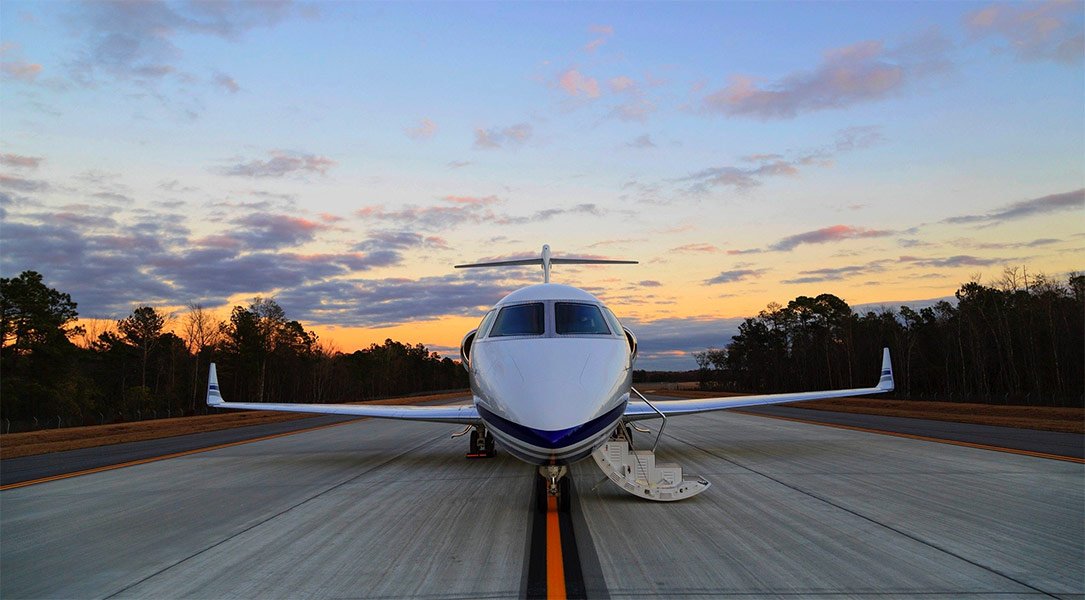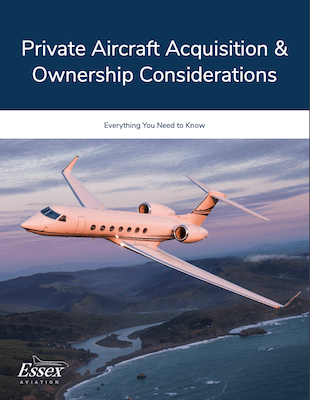
As appealing as aircraft ownership can be, it doesn’t make practical sense for every client, especially if their utilization falls below a certain number of hours per year. Clients who fall into this category should consider alternative options such as chartering, a membership program, fractional ownership or — the subject of this blog post — a co-ownership arrangement.
What Is Aircraft Co-ownership?
Aircraft co-ownership is exactly what it sounds like: Shared ownership of an aircraft between multiple parties. These parties enter what is known as an aircraft partnership agreement. Co-ownership is more common between individual owners versus corporations.
It’s important to understand that co-ownership is not the same as fractional ownership. In a fractional partnership, multiple parties purchase shares of a specific type of aircraft, and each is allotted a certain number of flight hours per year. Fractional share owners have title to a percentage of an aircraft based on their share size or annual allotted hours. Fractional programs are managed by the fractional program provider, who is responsible for the management, scheduling and maintenance of the aircraft, providing pilots and crew members, purchasing insurance coverage and other general operating costs for the share owners. Participants in fractional programs can upgrade or downgrade through an interchange program; this enables them to utilize other aircraft models that best meet the requirements of each trip.
Fractional program aircraft are part of a shared fleet in which all the share owners have access to the full fleet. It is not uncommon that a fractional share owner may never actually fly on the aircraft they own.
Co-owned aircraft will normally be placed with a third-party aircraft management company so that the aircraft can be utilized for third-party charter, which can offset a portion of the ownership costs. The partners in a co-ownership charter aircraft can review and approve charter trips for their aircraft, whereas fractional program aircraft are chartered at the discretion of the fractional program provider.
How Are Aircraft Partnerships Structured?
Co-ownership arrangements involving two or more parties should abide by a formal partnership agreement regarding the shared use of the aircraft. This agreement should always be finalized by the parties before the acquisition of the aircraft is completed; this way, all parties are clear on their mutual terms before making the investment and taking on the responsibility of co-ownership.
The agreement should be drafted by an attorney familiar with the aviation industry and arrangements of this type. Terms to address in this agreement should at a minimum include:
- The aircraft’s home base
- Management of the aircraft — will it be handled internally or by a third-party aircraft management company?
- How flights will be scheduled between co-owners, plus any scheduling or flight limitations
- How financial contributions are to be calculated
- Whether one or more co-owners can provide additional short-term funding in the event that others are unable to meet their financial obligations (due to rising costs, unforeseen business events and so on.)
- Pilot requirements, qualifications and restrictions
- The process for agreeing to and implementing refurbishments, maintenance overhauls, upgrades and so on
- Which decisions may be made at individual owners’ discretion, and which need to be made collectively
- What to do when one or more co-owners wants to sell their share of the aircraft
- How to address reckless behavior, irresponsible ownership or a violation of the co-ownership terms
- What to do in the case of a co-owner’s death, termination, divorce or other influential life event
It is imperative that co-owners work with aviation legal and tax counsel to determine the best ownership structure. These experts will determine how taxes are collected on the aircraft and ensure each owner is protected under the terms of the partnership.
The Benefits of Aircraft Co-ownership
There are many reasons individuals or companies might choose to enter into this kind of partnership, not least of all the fact that no owner is solely responsible for the aircraft and its needs.
- Co-ownership can be appealing to prospective buyers who would like to utilize a private aircraft but with a lower investment. Entering into an aircraft partnership enables all parties involved to distribute fixed costs in either an equal or otherwise structured manner as defined in the partnership agreement.
- An aircraft partnership might also be appealing to companies or individuals considering an alternative arrangement, such as fractional ownership, but for various reasons might prefer entering a partnership with a person or entity they already know and trust.
Aircraft Co-ownership vs. Full Ownership: Pros & Cons
| Co-ownership | Full Ownership |
|---|---|
| Pros | Pros |
| More practical option for those with lower utilization rates | More practical option for those needing higher utilization |
| May afford a larger or newer aircraft than with individual acquisition | Complete privacy regarding use of the aircraft |
| Fund only portions of fixed and variable costs | More flexibility in terms of scheduling |
| Can partner with a known and trusted individual or entity | Greater influence on crew selection and possibly selection of home base location |
| Freedom to modify or schedule maintenance for the aircraft without the need for partnership approval | |
| Cons | Cons |
| Finding the right partner(s) can be challenging | Sole funding for all acquisition, fixed and operating costs |
| Partnerships can become contentious | |
| Need to coordinate aircraft scheduling around other partners | |
| All parties need to agree to have modifications or refurbishments done to the aircraft | |
| More partners can lead to more complexity |
Is Aircraft Co-ownership Right for Me?
Based on your travel needs and requirements, aircraft co-ownership can be an economical and rewarding choice, especially for those who can’t or don’t want to commit to sole ownership. Provided you find the right partners — ones who are responsible, trustworthy and diplomatic — aircraft co-ownership allows you to take to the skies in comfort and style at a fraction of the price.
Any business or individual who flies around 200 or fewer hours per year should consider co-ownership to maximize their investment. The NBAA advises full ownership for companies or individuals that anticipate utilizing their aircraft for at least 250 flight hours per year.
While guidelines for utilization from the NBAA and other sources are worth consideration, there can be other factors that affect whether co-ownership is the best choice. For example, are there alternative travel options — such as charter or membership programs — available in your area that would meet your needs just as well as co-owning an aircraft? Other factors regarding your travel profile, such as security measures and personal aircraft preferences, may influence your best options.
How to Get Started with Aircraft Co-ownership
While there are many factors to fully understand and consider with private aircraft partnership, the arrangement may fit your immediate needs and grant you expanded options for accessing a private aircraft with reduced costs.
Partnerships can run the full gamut, from owners actually traveling together quite often (keeping scheduling conflicts to a minimum), to partners who have no prior relationship and are introduced simply by having the mutual desire to own and have access to a portion of an aircraft.
Scheduling arrangements aside, there are many other items to address at the beginning of an aircraft co-owner partnership, such as:
- Philosophy of care and custody – While the FAA prescribes minimum standards to operate and maintain an aircraft, there are additional decisions to be made which may include: employing home base services, cleaning and preservation standards, recommended and optional maintenance tasks, upgrades such as refurbishment of paint and interior or modifying with new or better equipment.
- Crewing – It is best if co-owners have compatible objectives regarding the desired qualifications of the flight crew and perhaps a maintenance technician. Co-owners should also address whether additional or contract crew members may be needed and if so, how that might be determined and funded.
- Fixed costs – While sharing fixed costs is a benefit to partnership arrangements, all partners need to agree on points such as amounts of insurance liability and the types of crew training deemed appropriate.
- Exit strategy – Besides working with a private aviation attorney to establish fundamental exit strategies for all partners, there should also be an exit strategy for the aircraft itself. Co-owners also need to agree on the timing of major inspection events, a refurbishment or equipment upgrade.
All told, if an aircraft partnership is established and organized to operate privately, these and other predictable matters are best handled long before any real-time decisions are necessary.
Another possibility is that the aircraft be placed with a professional management company, whereby a number of decisions can be deferred to and handled by this third party. While this relationship structure will likely require a single contact or representative of the partnership, it may in fact support the partnership in operating at its best.
A qualified private aviation consultant, such as those at Essex Aviation, can help prospective aircraft owners determine which option — co-ownership or otherwise — makes the most practical sense based on their requirements.
Are You Ready to Acquire a Private Aircraft?
Read our eBook to be sure you’ve checked all the boxes before starting the acquisition process.







